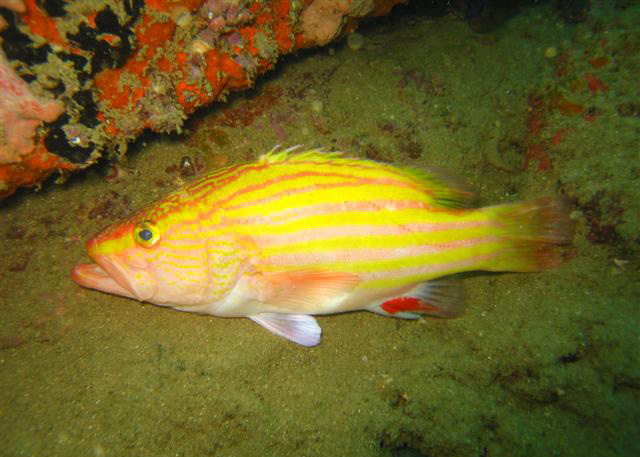| Epinephelidae (Groupers) |
| 30 cm TL (male/unsexed) |
|
demersal; marine; depth range 35 - 365 m |
| Western Atlantic: off North Carolina (pelagic post-larva, possibly drifted north from Florida or the Bahamas) to the Gulf of Mexico, Caribbean, and south to Vitoria, Brazil. |
|
Dorsal spines (total): 8-8; Dorsal soft rays (total): 13-13; Anal spines: 3-3; Anal soft rays: 7-7. Distinguished by the following characteristics: head, body, dorsal and caudal fins yellow; 6-7 salmon-colored stripes from the head to the soft dorsal and caudal fins; blood-red blotch on the front half of anal fin; white blotch on the side of belly; pinkish purple pelvic fins; depth of body subequal to head length, depth contained 2.3-2.5 times in SL; width of body 2.3-2.4 times in body depth; head length 2.2-2.3 times in SL; convex interorbital area, convex dorsal head profile; rounded preopercle, with large, curved spine at angle, lower edge fleshy; very large middle opercle spine, extending to or beyond rear edge of opercular membrane; small posterior and anterior nostrils, subequal; well-developed supramaxilla and prominent bony knob (hidden by upper lip) on lower rear corner; short, curved, fixed canine tooth on each side of symphysis of both jaws and midside of lower jaw with 1-3 similar fixed canines (Ref. 89707). |
| A solitary species (Ref. 26340) inhabiting sandy bottoms and reefs (Ref. 89707). A beautiful and hardy species in the aquarium, prefers cooler waters and not good community dwellers for they are active piscivores (FB user, 27/04/12 ). |
|
Least Concern (LC); Date assessed: 15 November 2016 Ref. (130435)
|
| harmless |
Source and more info: www.fishbase.org. For personal, classroom, and other internal use only. Not for publication.

